
Which L sugar on oxidation gives an optically active dibasic acid ( 2 - COOH groups)?
A)

B)

C)
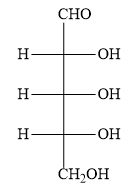
D)
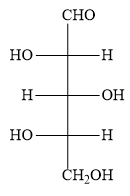




Answer
574.8k+ views
Hint: In the Fischer projection formula for D-sugar, the bottom most asymmetric carbon atom has hydroxyl group on the right. In the Fischer projection formula for L-sugar, the bottom most asymmetric carbon atom has hydroxyl group on the left. When a sugar molecule is oxidised, the product is a dibasic acid. If a plane of symmetry is present, the product is optically inactive.
Complete step by step answer:
The options B ) and C ) represent D- sugars as in the fischer projection formula, the bottom most asymmetric carbon atom has hydroxyl group on the right. But in the question, you have to find optically active dibasic acid from L-sugar. Hence, the options B ) and C ) are ruled out.
The options A ) and D ) represent L- sugars as in the fischer projection formula, the bottom most asymmetric carbon atom has hydroxyl group on the left.
When a sugar molecule is oxidised, the aldehyde group is converted to a carboxylic group. Similarly, the primary alcohol group is also oxidised to the carboxylic group. Thus, the oxidation of sugar gives a dicarboxylic acid. The product is dibasic acid with two carboxylic acid groups.
When the sugar in option D ) is oxidized, the product dicarboxylic acid contains a plane of symmetry (a mirror plane). Hence, the product is optically inactive. But in the question, you have to find optically active dibasic acid from L-sugar. Hence, the option D ) is ruled out.
When the sugar in option A ) is oxidized, the product dicarboxylic acid does not contain a plane of symmetry (a mirror plane). Hence, the product is optically active. In the question also, you have to find optically active dibasic acid from L-sugar.
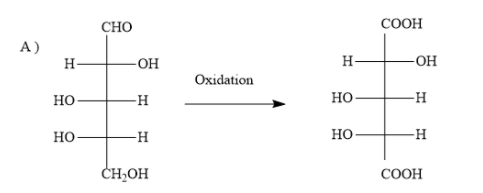
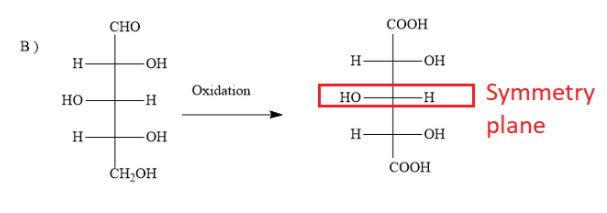
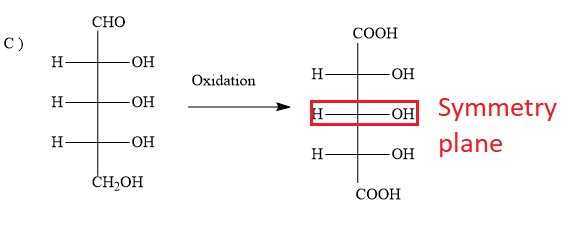

Hence, the option A ) is the correct option.
Note: When a symmetry plane is present, the product will be optically inactive due to internal compensation. Such products are meso forms. When a symmetry plane is absent, the product is optically active and present as enantiomeric pairs.
Complete step by step answer:
The options B ) and C ) represent D- sugars as in the fischer projection formula, the bottom most asymmetric carbon atom has hydroxyl group on the right. But in the question, you have to find optically active dibasic acid from L-sugar. Hence, the options B ) and C ) are ruled out.
The options A ) and D ) represent L- sugars as in the fischer projection formula, the bottom most asymmetric carbon atom has hydroxyl group on the left.
When a sugar molecule is oxidised, the aldehyde group is converted to a carboxylic group. Similarly, the primary alcohol group is also oxidised to the carboxylic group. Thus, the oxidation of sugar gives a dicarboxylic acid. The product is dibasic acid with two carboxylic acid groups.
When the sugar in option D ) is oxidized, the product dicarboxylic acid contains a plane of symmetry (a mirror plane). Hence, the product is optically inactive. But in the question, you have to find optically active dibasic acid from L-sugar. Hence, the option D ) is ruled out.
When the sugar in option A ) is oxidized, the product dicarboxylic acid does not contain a plane of symmetry (a mirror plane). Hence, the product is optically active. In the question also, you have to find optically active dibasic acid from L-sugar.




Hence, the option A ) is the correct option.
Note: When a symmetry plane is present, the product will be optically inactive due to internal compensation. Such products are meso forms. When a symmetry plane is absent, the product is optically active and present as enantiomeric pairs.
Recently Updated Pages
The number of solutions in x in 02pi for which sqrt class 12 maths CBSE

Write any two methods of preparation of phenol Give class 12 chemistry CBSE

Differentiate between action potential and resting class 12 biology CBSE

Two plane mirrors arranged at right angles to each class 12 physics CBSE

Which of the following molecules is are chiral A I class 12 chemistry CBSE

Name different types of neurons and give one function class 12 biology CBSE

Trending doubts
Which are the Top 10 Largest Countries of the World?

What are the major means of transport Explain each class 12 social science CBSE

Draw a labelled sketch of the human eye class 12 physics CBSE

Differentiate between insitu conservation and exsitu class 12 biology CBSE

The computer jargonwwww stands for Aworld wide web class 12 physics CBSE

State the principle of an ac generator and explain class 12 physics CBSE




